4.3.2 GB/T4798.2 Environmental conditions for the application of electrical and electronic products - Part 2: Transportation
This section discusses the environmental parameter groups that products are subjected to during transportation from one place to another, as well as their
The severity has been graded.
This section considers the most commonly used transportation methods, mainly including the following:
Road transportation: cars, trucks, animals, conveyor devices;
Rail transportation: trains, trams, transmission devices;
Water transportation, inland and ocean transportation: ships, hovercraft, transport devices;
Air transportation: aircraft, conveyor devices;
Vertical transportation: cranes, transport elevators, cable cars.
This section specifies the environmental conditions that products may encounter during transportation. If the product comes with packaging, the environmental conditions apply to the packaged product. This section only includes harsh environmental conditions that are detrimental to the product.
The purpose of this section is to classify the environmental parameter groups that products may withstand during land, water, and air transportation, including loading and unloading processes.
This section provides a limited number of environmental condition levels, but covers a wide range. Users should choose the lowest level that includes the environmental conditions to be transported, and guidelines are provided in Appendix A.
1. Overview
To avoid misuse of the levels specified in GB/T4798, it is recommended to refer to GB/T4798.10.
The specified values for severity levels are either maximum or limit values, and the likelihood of being exceeded is very low, but they may reach these values in a short period of time. In different situations, the frequency of occurrence may vary within different time periods. This section does not include the frequency of occurrence, but every environmental parameter should be considered. If possible, it should be specified separately.
Information on duration and frequency of occurrence is provided in Chapter 6 of GB/T4798.10.
It should be noted that the combination of several environmental parameters can increase the impact on the product. Especially when high relative humidity is combined with biological environmental conditions, chemical active substances, and mechanical active substances, it has a significant impact on the product.
2. Environmental parameter groups and their severity grading
Climatic environmental conditions (K), special climatic environmental conditions (Z), biological environmental conditions (B), chemically active substances (C), mechanically active substances (S), and mechanical conditions (M) are classified according to Tables 1 to 5. For a given product, a complete set of hierarchical descriptions should be used, such as 2K2/2B1/2C2/2S2/2M3, see Chapter 6.
The classification of tropical regions 2K6 and 2K7 is explained in Appendix C.
The lowest level combination 2K1/2B1/2C1/2S1/2M1 represents the environmental conditions that the product can withstand under the strictest transportation conditions, while the highest level combination 2K5/2B3/2C3/2S3/2M4 includes a wide range of transportation conditions, including very harsh environmental conditions.
High level environmental conditions generally include all low level conditions.
It is currently difficult to quantify the severity of certain environmental parameters.
The environmental conditions included in each level are given in A.3 of Appendix A.
3. Environmental condition level combination
As mentioned in the previous section, when used, multiple combinations of environmental conditions that the product may withstand are allowed in the grading. Therefore, there are many possible combinations of levels and flexibility. However, in practical processes, this flexibility and diversity are not always advantageous, for example, when different organizations establish environmental conditions norms for a certain location, small and more troublesome differences may arise.
To limit the likelihood of general situations, standard level combinations can be selected from Table 6. For designated locations or products, please refer to this section, such as selecting IE22. Only when there are no corresponding environmental conditions in this section can each level be explained according to the previous section. Alternatively, if there is a deviation between the severity parameter and the level combination of certain environmental parameters, the text 'but... (parameter)... (severity and unit)' can be added, such as IE22, but sand is 10g/m3.
Appendix B summarizes the environmental conditions included in each combination of environmental condition levels.
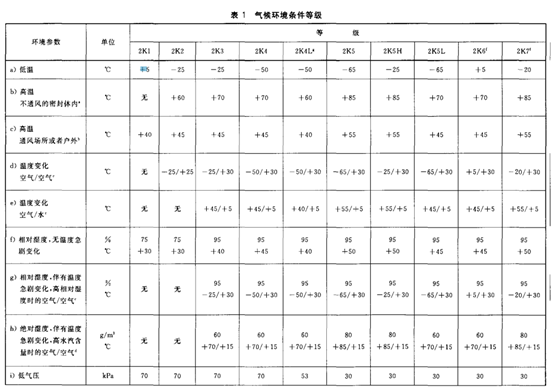
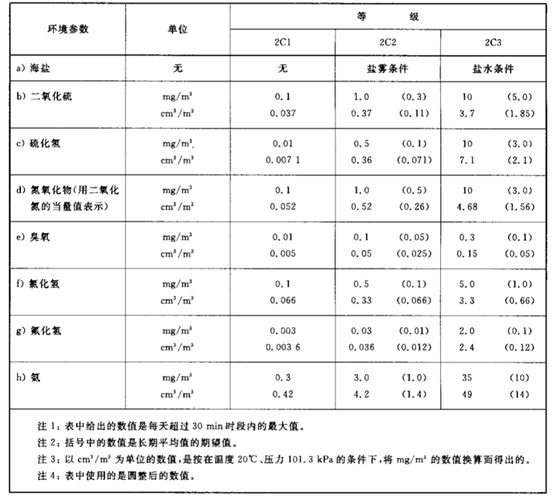
Table 2 Levels of Biological Environmental Conditions
环境参数 | 等级 |
2B1 | 2B2 | 2B3 |
a)植物群 | 无 | 存在霉菌、 真菌等 |
b)动物群 | 无 | 存在啮齿动物及其他危害产品的动物 |
白蚁除外 | 包括白蚁 |
Table 3 Condition Levels of Chemical Active Substances

Table 4 Condition Levels of Mechanically Active Substances
环境参数 | 单位 | 等级 |
2S1 | 2S2 | 2S3 |
a)空气中的沙尘 | mg/m3 | 无 | 0.1 | 10 |
b)沉积沙尘 | mg/(m2・h) | 无 | 3.0 | 3.0 |
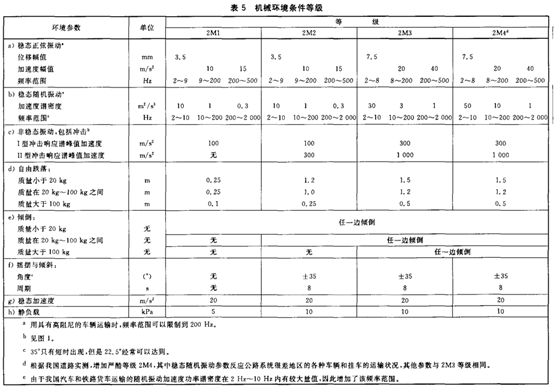
Table 6 Classification of Environmental Parameter Combination Levels
条 件 | 环境参数组合等级分组 |
IE21 | IE22 | IE23 | IE24 |
气候 生物环境 化学活性物质 机械活性物质 机械条件 | 2K2 2B2 2C2 2S2 2M1a | 2K3 2B2 2C2 2S2 2M1 | 2K4 2B2 2C2 2S2 2M2 | 2K5 2B2 2C2 2S3 2M3 |
a 表5的脚注a适用。 |
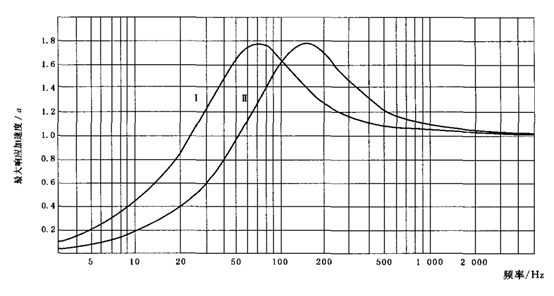
Figure 1 Typical shock response spectrum (first order maximum shock response spectrum)
Example of half sine pulse duration:
Spectrum I: duration of 11ms;
Spectrum II: Duration 6ms.
Appendix A (informative appendix) Selection of environmental parameters and severity levels
A. 1 Overview
This appendix explains the basis of classification, studies the impact of various factors on the selection of environmental parameters and their severity levels, provides an overview of the environmental conditions covered by each level, and provides application examples.
A. 2. Research on Environmental Conditions
For each environmental parameter, various possible conditions that may lead to different levels of environmental conditions are listed, and various conditions are arranged as much as possible to form more severity levels.
A. The first columns from 2.1 to A.2.5 describe various conditions in each level column 'X' indicates that the level includes the condition. The lowest level containing a certain condition can be found from the first 'X' in the row where the condition is located.
The process of finding the appropriate level mentioned above applies to all the following clauses, but it should be noted that climate types are also included in A.2.1.
The lowest level including a certain condition can be queried by first following the relevant climate type column down to the first 'X' in the relevant condition row, and then reading horizontally to the right until the first 'X' described in the above method.
The climate types specified in GB/T4797.1-2005 are as follows: extreme cold (excluding central Antarctica), cold, cold temperature, warm temperature, dry heat, moderate dry heat, extremely dry heat, humid heat, (constant) humid heat.
It should be noted that when a certain condition is included in a certain level in this appendix, it does not mean that for each environmental parameter, the level describes the minimum severity required to include the condition.
Note: Incidents are not included. However, at certain levels, it may be necessary to consider the possibility of occasional events. For example, during transportation on a ship, the packaging of the product was damaged due to the leakage of liquid near the container.
A. 2.1 Climatic Environmental Condition Level K

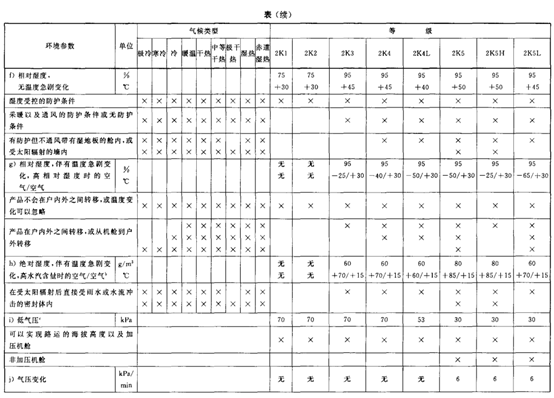

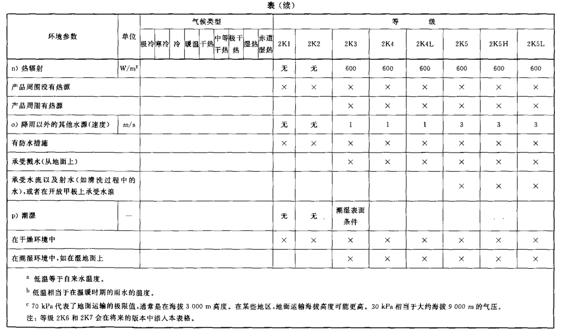
A. 2.2 Biological condition B
运输条件 | 等级 |
2B1 | 2B2 | 2B3 |
a)植物群 | 无 | 存在霉菌、 真菌等 |
霉菌、真菌生长可能性很小的地区或者有防止霉菌、真菌生长措旋的场所 | X | X | X |
b)动物群 | 无 | 存在啮齿动物及其他危害产品的动物 |
白蚁除外 | 包括白蚁 |
白蚁、啮齿类动物或其他动物对产品危害很小的地区,或者有动物防护的地区 | X | X | X |
啮齿类动物或其他动物对产品可能造成危害,没有动物防护的地区 |
| X | X |
动物,包括白蚁可能对产品造成危害的地区 |
|
| X |
A. 2.3 Chemical active substance C
运输条件 | 等级 |
2C1 | 2C2 | 2C3 |
a)海盐 | 无 | 盐雾条件 | 盐水条件 |
户内、气候防护场所(包括有防护海洋运输) | X | X | X |
无气候防护陆地运输 |
| X | X |
无气候防护海洋运输 |
|
| X |
b)二氧化硫 | mg/m3 | 0.1 | 1.0 | 10 |
c)硫化氢 | mg/m3 | 0.01 | 0.5 | 10 |
d)二氧化氮 | mg/m3 | 0.1 | 1.0 | 9.0 |
e)臭氧 | mg/m3 | 0.01 | 0.1 | 0.3 |
f)氯化氢 | mg/m3 | 0.1 | 0.5 | 5.0 |
g)氟化氢 | mg/m3 | 0.003 | 0.03 | 2.0 |
h)氨 | mg/m3 | 0.3 | 3.0 | 35 |
没有工业,或者没有永久车辆交通、不在工业区附近,或者中等工业活动和交通地区的密封场所内 | X | X | X |
没有大量化学污染物排放的一般工业区 |
| X | X |
有大量化学污染物排放的工业区 |
|
| X |
A. 2.4 Mechanically active substance S
运输条件 | 等级 |
2S1 | 2S2 | 2S3 |
a)空气中的沙尘 | mg/m3 | 无 | 0.1 | 10 |
b)沉积沙尘 | mg/(m2*h) | 无 | 3.0 | 3.0 |
有气候防护且有防尘措施,清理过程中不包括对积有灰尘的地面的清扫。 | X | X | X |
有气候防护但没有防尘措施。有清扫积有灰尘的地面的活动,无气候防护且无防尘措施,除沙漠以外的世界范围区域 |
| X | X |
无气候防护且无防尘措施,世界范围区域 |
|
| X |
A. 2.5 Mechanical environmental conditions M
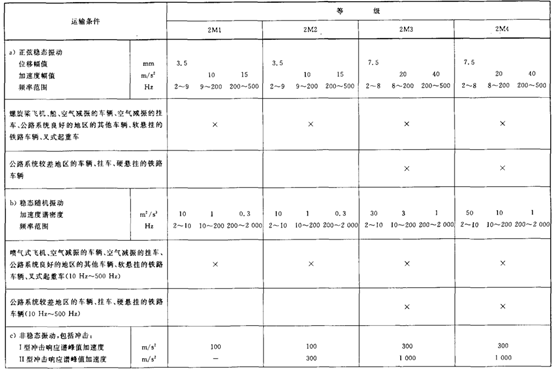
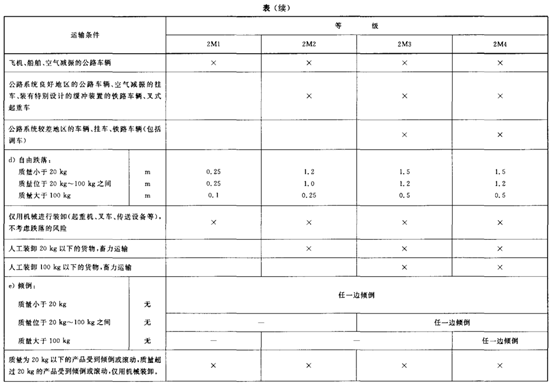
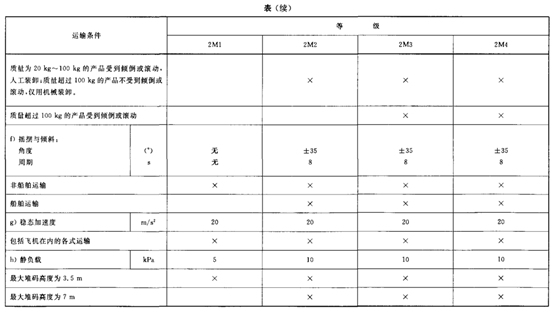
A. Summary description of the conditions covered by each level
This chapter includes explanations for all levels and provides application examples.
A. 3.1 K Climatic Environmental Conditions
The description of the 10 levels of climatic and environmental conditions is as follows:
2K1 includes general transportation conditions with climate protection, heating, and ventilation. High temperature conditions are limited to general outdoor climatic conditions. The humidity conditions in outdoor climates worldwide are not more severe than those in general outdoor climates, so there are no restrictions on humidity conditions.
The product does not move between cold outdoors and warm indoors.
The product may be exposed to solar radiation through windows or other openings. The product is not close to the heating element and is not affected by splashing water or wet walls.
In addition to the conditions of 2K1, 2K2 also includes non heating and climate protection conditions in general outdoor climates other than cold and warm. This level also includes transportation within the ventilated housing.
The product can be transported in a heated and pressurized cabin.
In addition to the conditions included in 2K2, 2K3 also includes non ventilated sealed bodies in general outdoor climates other than cold and warm, as well as transportation without climate protection. When transported by air, it is only included in the heated and pressurized cabin for transportation.
The product can be moved between cold outdoor and warm indoor environments. The product can be directly affected by solar radiation, precipitation, and splashing.
The product can be placed on damp floors and sealed bodies affected by solar radiation and precipitation. When exposed outdoors, it will not be impacted by waves. The product can be placed near a heat source.
In addition to the conditions of 2K3, 2K4 also includes transportation without climate protection in cold and warm climate conditions.
In addition to the conditions of 2K3, 2K4L also includes transportation on the ground at an altitude of 3000m to 5000m (excluding cold areas).
In addition to the conditions of 2K4, 2K5 also includes transportation in non ventilated sealed bodies and non climate protected conditions worldwide, as well as in non pressurized engine rooms. The product can be affected by the impact of waves when transported on the ship deck, and can also be affected by clean water flow.
2K5H is similar to 2K5, but the low-temperature conditions are the same as 2K3 level.
2K5L is similar to 2K5, but the high temperature conditions are the same as 2K4 level.
2K6 2K6 represents the outdoor climate of humid heat and similar humid heat (the humid heat climate type in tropical rainforest areas).
2K7 2K7 represents the outdoor conditions of dry heat, moderate dry heat, and extremely dry heat climates (equatorial dry climate near the equator, such as in desert areas).
A. 3.2 B Biological Environmental Conditions
The biological conditions included in the three levels are explained as follows:
2B1 This level includes transportation conditions in areas without obvious biological (animal and plant) hazards. This includes transportation conditions in compartments that are unlikely to grow mold or be endangered by animals.
In addition to the conditions included in 2B1, 2B2 also includes areas with mold growth and animal hazards but without termite hazards.
In addition to the conditions included in 2B2, 2B3 also includes areas where termite harm may occur.
A. 3.3 C Chemical active substance conditions
The conditions included in the three levels are explained as follows:
2C1 includes various transportation conditions where the product is placed in a closed body with salt spray protection measures, and is only transported in areas with moderate industrial and transportation activities.
In addition to the conditions included in 2C1, 2C2 also includes transportation outside the closed body outside the open deck of ships, including transportation within general industrial activity areas, but does not include areas where large amounts of chemical pollutants are discharged.
2C3 2C3 includes all transportation conditions, including sea transportation, salt spray free protection measures, and transportation in highly polluted areas.
A. 3.4 Conditions for S mechanically active substances
The description of the three levels is as follows:
2S1 2S1 includes various situations of transportation within enclosed bodies with sand and dust protection measures.
In addition to the conditions included in 2S1, 2S2 also includes transportation outside the enclosed area where dust accumulates, excluding transportation in desert areas.
In addition to the conditions included in 2S2, 2S3 also includes enclosed external transportation in desert areas.
A. 3.5 M mechanical environmental conditions
The four levels are explained as follows:
2M1 includes mechanical shipping and transportation of aircraft, ships, and air damping truck trailers.
In addition to the conditions of 2M1, 2M2 also includes the transportation of various truck trailers in areas with good road systems, as well as railway and ship transportation with specialized buffer facilities.
In addition to the conditions of 2M2, 2M3 also includes various modes of transportation and transportation in areas with poor road conditions.
In addition to the conditions of 2M3, 2M4 also includes the transportation of various vehicles and trailers in areas with poor road systems.
Appendix B (informative appendix) Overview of the inclusion conditions for each level combination
This appendix includes summary descriptions of four standard environmental condition categories.
Please refer to Appendix A for detailed instructions.
Common environmental conditions are described in the following four categories:
The combination of IE21 levels includes transportation conditions in ventilated enclosed areas and climate protected areas. If transported by aircraft, only heating and pressure chambers are included; There is a possibility of mold growth and harm from organisms (excluding termites); Within general industrial areas but without a large amount of chemical pollutants; Excluding desert areas; Transportation of aircraft, ships, and air damping truck trailers (in high damping areas inside the vehicle).
In addition to the conditions included in IE21, IE22 also includes non ventilated enclosed bodies and non climate protected transportation in railway transportation and truck trailers with air damping; In areas where the vehicle does not have high damping.
In addition to the conditions included in IE22, IE23 also includes transportation within all vehicles and trailers; Transportation in areas with good highway systems; Railway transportation and ship transportation with specialized buffer facilities.
In addition to the conditions included in IE23, IE24 includes transportation worldwide, including transportation in non pressurized compartments; If transported on the deck of a ship, the product will be affected by waves, water currents, or clean water currents; Transportation in desert areas; Transportation in areas with poor highway systems.
Appendix C (informative) Explanation of 2K6 and 2K7 level environmental conditions
C. 1 Overview
The tropics refer to the area between the Tropic of Cancer and Tropic of Cancer (i.e. between latitude 23 ° 27 'S and latitude 23 ° 27' N).
The following outdoor climate types specified in GB/T4797.1 include dry heat, moderate dry heat, extreme dry heat, humid heat, and constant humid heat.
The tropics are areas on Earth that experience high daytime temperatures, often accompanied by heavy rainfall, and have little seasonal variation.
The tropical climate ranges from the humid and hot climate of the tropical rainforest on the equator to the dry and hot climate in the desert near the Tropic of Cancer. Therefore, it is necessary to distinguish between two tropical climates.
——A dry hot climate with dry heat, moderate dry heat, and extreme dry heat.
——A humid hot zone climate with damp heat and constant damp heat.
Some regions, due to their special altitude, have significantly different climate conditions from those of the same latitude, such as solar radiation and pressure, or ice and snow on mountain tops. In tropical regions, there are many places where the environmental conditions are relatively stable, while in other areas, there are significant changes.
Stable situation:
——Daily minimum temperature fluctuation<1 ℃, annual temperature fluctuation ≤ 6 ℃;
——The daytime time is stable between 10.5h and 13.5h;
——The intensity of solar radiation remains unchanged;
——A balanced survival of various animals.
Extreme situations:
——Precipitation, the annual precipitation near the equator, and the heavy rain in the near tropical region during a certain period of each year;
——A tropical cyclone in the sea, with a wind speed of 30m/s and a maximum of 60m/s, such as typhoons in the Western Pacific and hurricanes in the Caribbean.
——Unsuitable soil conditions for cultivation: In heavy rain areas, there is a serious loss of humus and inorganic matter;
——In deserts, high temperatures and strong winds quickly dry the soil;
——The dense vegetation of tropical rainforests, with less dense vegetation in mountainous forests;
——Tropical savannas and other grasslands, deserts have no vegetation.
C. 2 Climate map
The climate map of two types of climate conditions in tropical regions is shown in Figure C.1, which is the average annual extreme values of temperature and humidity according to the climate types specified in C.1.
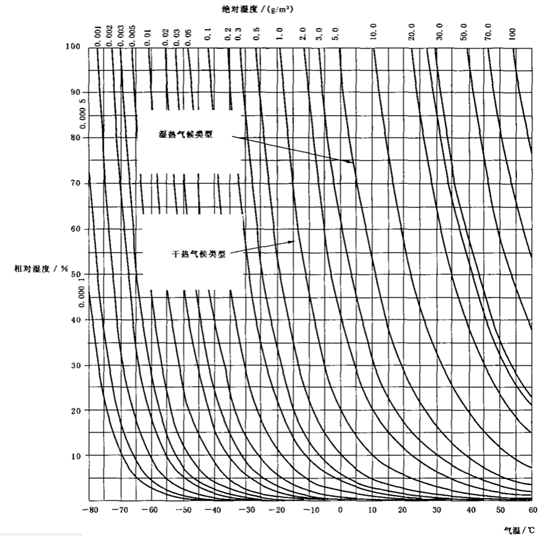
Figure C.1 Climate Map of Wet and Dry Heat Types